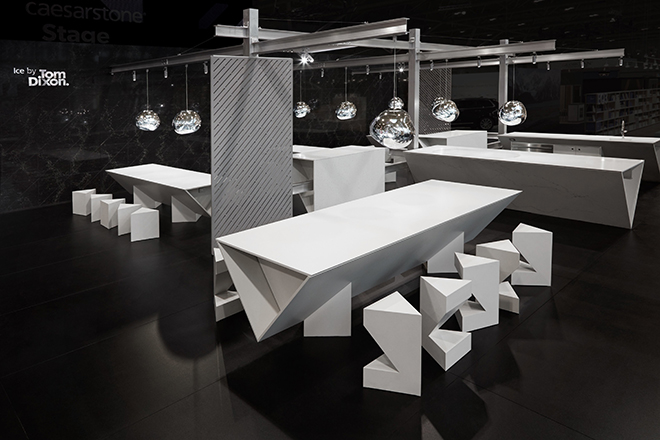Caesarstone, a leading manufacturer of premium quartz surfaces, has now revealed ICE, an ice-inspired kitchen installation designed by Tom Dixon.
The first installment of Caesarstone’s year-long collaboration with Dixon for 2016 has been unveiled at the Interior Design Show (IDS) in Toronto (21-24 January 2016), where Caesarstone has previously presented work by Nendo, Raw-Edges and Philippe Malouin.
ICE was inspired by Canada’s impressive frozen lakes and the formidable icebreakers that clear the way for freighters during the winter. Powering their way through the ice, they leave behind a frozen mix of jagged pieces in a spectacular array of whites and greys. A series of large monolithic triangular prisms in different sizes and heights form the base of the ice kitchen creating food prep area, serving stations, surfaces and stools.
The Toronto ice kitchen is the first of four semi-professional kitchens inspired by the elements of Ice, Fire, Earth and Air. The concept celebrates local heroic foods from four chosen cities spanning multiple locations including Milan for Milan Design Week, North America and Asia (full list to be revealed in 2016). The four kitchens will create theatres of food and cooking that demonstrate the hard wearing qualities, durability and beauty of Caesarstone.
For each installation, Tom Dixon will be using a secondary material that will form part of the element’s narrative and allow him to present Caesarstone in extraordinary and new ways. For Toronto, Dixon has chosen an aluminium extrusion system developed for flat pack housing, delivering a cold industrial aesthetic, whilst acting as the structural support and lighting rig for the installation, where Dixon’s Melt Lights complement the ice theme.
“In our Toronto show we propose a food preparation and consumption space, which draws on the analogy of the kitchen as an alchemist’s laboratory where raw materials are transformed into treasure through the elemental process of freezing, melting, shaving and cooking with ice,” says Tom Dixon. “Where the contemporary kitchen seeks to hide the activities behind a series of minimal blocks, here we expose the chopping, the steaming, the freezing, the scouring and the disposal of waste in all its active glory.”



